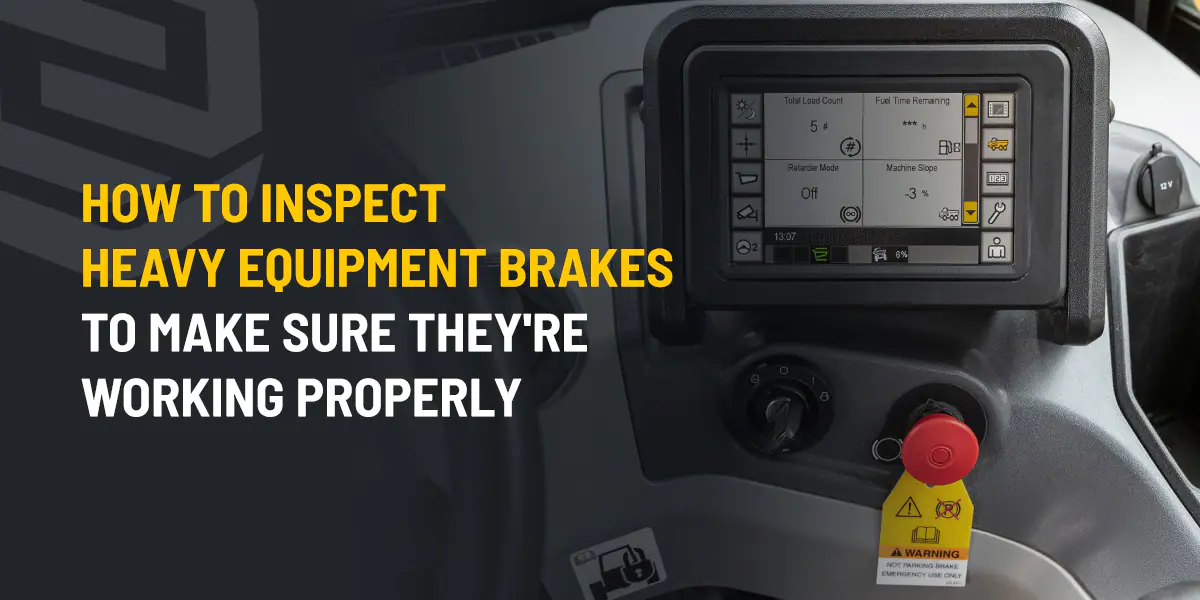
How to Inspect Heavy Equipment Brakes to Make Sure They’re Working Properly
Category: Equipment and Solutions
While heavy equipment like bulldozers, excavators and wheel loaders typically don’t travel at high speeds, operators must be able to stop their machines quickly and reliably to ensure safety on a job site. The ability to stop safely is also necessary to comply with Occupational Safety and Health Administration (OSHA) guidelines, which stipulate that earthmoving equipment must include a braking system capable of stopping and holding the machine when fully loaded.
Types of Braking Systems and How They Work
Because of the extreme variations in heavy equipment designs, various braking system types are standard throughout the industry. Many heavy equipment braking systems rely on the machine’s primary hydraulic system for power. Some examples include:
- Disc brakes: Disc brakes are popular on many types of heavy equipment because of their low cost and versatility, and they’re especially common on a machine’s front axles. These systems work by reducing the speed of each wheel individually. They use pads that squeeze the rotor to create the friction necessary to slow the machine.
- Drum brakes: Drum brakes typically work as an independent system on a machine’s rear axle. Unlike disc brakes, they don’t use pads to create the friction required to stop. Instead, the system contains a wheel cylinder with pistons that push shoes against a spinning drum.
- Wet multidisc brakes: These systems are popular in agricultural machinery and other heavy-duty equipment. They are often immersed in oil to eliminate overheating and provide quick stopping action in harsh operating conditions. These systems mount to the machine’s differential.
Some heavy equipment types, like articulated trucks and wheel loaders, use air brakes that operate independently of your hydraulic system. Rather than using hydraulic fluid, air brakes use compressed air to apply pressure to the calipers or drums to slow or stop the machine.
What Can Happen if You Don’t Maintain Your Brakes?
Brake problems often remain relatively invisible until they affect a machine’s performance. Besides wear and tear, many brake issues can occur from imbalance or timing problems. When brake failure happens, it’s usually because the system is not getting sufficient engagement or is disengaging correctly.
Some symptoms of a faulty brake system can include:
- Failing to engage
- Squealing or squeaking
- Vibrating or pulsing
- Dragging or failing to disengage
In some cases, easy fixes include adding fluid, bleeding the brake lines to remove the air, replacing worn shoes or pads, resurfacing a rotor or repairing worn bearings. Whatever the issue, it’s important to use genuine brake parts that perfectly fit your machine to ensure safe operation, as brake failure can cause serious hazards on the job site.
How to Perform a Heavy Equipment Brake Inspection
Addressing a brake problem right away is critical, as ignoring any potential issue can often lead to more severe troubles down the road. Frequent visual inspections go a long way in identifying problems early. Monitoring your equipment’s hours or mileage also reminds you when it’s time for service.
A walkaround and a quick undercarriage inspection should reveal any leaks indicating a potential problem. Areas to focus on include:
- Brake pads: When examining your pads, two primary things to look for are excessive and uneven wear. Excessive wear can indicate the need for replacement, while uneven wear might mean a caliper or another component is malfunctioning. Squeaking or squealing during engagement often suggests the presence of dirt or worn parts.
- Calipers: Caliper inspection involves ensuring the smooth operation of the caliper pistons and the sliding pins. Faulty calipers can also make your brake pedal feel spongy.
- Rotors: Besides inspecting your rotors for burn marks or corrosion, look for warping or excessive wear. Grinding noises when engaging the brakes often indicate a worn rotor.
- Hoses and tubing: Hose inspection involves checking for cracks, chafing and kinks while ensuring proper positioning and smooth connections.
- Fluid: When checking fluids, take care not to contaminate the system with dirt from the outside. A gauge can show you the fluid level if your braking system connects to your machine’s primary hydraulic system.
- Grease: Regular greasing of slack adjusters and camshafts can help prevent corrosion and rust. Slack adjuster greasing also protects the adjuster’s clutch and gear set from premature wear while pushing out the old grease, unwanted water and other contaminants.
- Parking brake: Testing the parking brake can be as easy as putting your machine in neutral gear on a slope with the parking brake engaged. If you operate a newer machine with advanced features, an indicator may alert you of a parking brake issue or other braking system problems.
Choosing NMC Cat for All Your Braking System Needs
If you need parts or brake service in or around Nebraska, your nearest NMC Cat location has you covered. Our expert technicians can perform the repair or maintenance service you need, from rotor and pad replacement to calibration and greasing.
Explore our comprehensive brake parts selection at parts.cat.com today. Feel free to contact our professional team with any questions.
